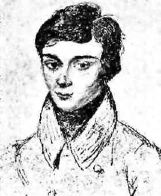

Evariste Galois' parents were both intelligent and well educated in philosophy, classical
literature and religion. His mother served as Galois' sole teacher until he was 12
years old. She taught him Greek, Latin and religion where she imparted her own scepticism to her son. Galois' father was an important man in the community
and in 1815 he was elected mayor of Bourg-la-Reine.
His school record is good, and he received several prizes. However Galois was asked to repeat one year because his work in rhetoric was not up to the required standard. In 1827, Galois enrolled in his first mathematics class. He quickly became absorbed in mathematics.
His school reports began to describe him as singular, bizarre, original and closed.
In 1828, Galois took the examination of the Ecole Polytechnique but failed. He worked more and more on his own researches and less and less
on his schoolwork. He studied Legendre's Géométrie and the treatises of Lagrange. In 1829, Galois had his first mathematics paper published on continued fractions, and he submitted articles on the algebraic solution of equations. Cauchy was appointed as referee of Galois' paper.
Later that year, his father committed suicide. Galois was deeply affected by his father's death and it greatly influenced the direction his life was to take. A few weeks after his father's death, Galois presented himself for examination for entry to the Ecole Polytechnique for the second time, and again failed. Galois therefore resigned himself to enter the Ecole Normale.
Galois sent Cauchy further work on the theory of equations, but then learned of a posthumous article by Abel which overlapped with
a part of his work. Galois then took Cauchy's advice and submitted a new article On the condition that an equation be soluble by radicals in 1830.
The paper was sent to Fourier to be considered for the Grand Prize in mathematics. Fourier died shortly thereafter, and Galois' paper was never subsequently found and so never considered for the prize.
Galois, after reading Abel and Jacobi's work, worked on the theory of elliptic functions and abelian integrals. With support from Sturm, he published
3 papers in 1830. For political reasons, Galois was expelled from school.
In 1831, Galois attempted to return to mathematics. He organized some mathematics classes in higher algebra which attracted 40 students to the first meeting but after that the numbers quickly fell off.
He was arrested for threatening the King, but was acquitted.
He was arrested again for wearing the uniform of the Artillery of the National Guard, which was illegal. He was also carrying a loaded rifle, several pistols and a dagger. While in prison, Galois attempted to commit suicide by
stabbing himself with a dagger, but the other prisoners prevented him. He was again released, and fell in love.
Galois fought a duel with Perscheux d'Herbinville over his new love, was wounded, and died the next day.
Galois' brother and his friend Chevalier copied his mathematical papers and sent them to Gauss, Jacobi and others. It had been Galois' wish that Jacobi and
Gauss should give their opinions on his work. The papers reached Liouville, who published them in his Journal in 1846. The theory that Galois outlined in these papers is now called Galois theory.